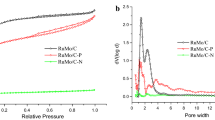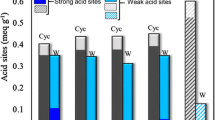Abstract
Raney nickel catalysts have been tested in the transformation of glucose into sorbitol through a hydrogen transfer pathway in the presence of short chain alcohols. Comparison between different sacrificing alcohols evidenced that catalytic hydrogen transfer (CHT) was only possible from ethanol under the tested neutral conditions. Catalytic tests showed that together with CHT route, sorbitol was also produced by means of sugar disproportionation, with the simultaneous production of gluconolactone, which takes place easily in the presence of the Raney Ni catalysts. Studies on the influence of the catalyst loading on the production of sorbitol revealed the existence of a catalyst activation step, attributed to the generation of metal-hydride species, the truly catalytic sites for hydrogenation. However, a catalyst deactivation phenomenon was detected as well. In this case, TGA and FTIR analysis allowed ascribing the adsorption of organic species, coming from the oxidation of glucose (such as gluconic acid), onto the catalyst surface, to the most plausible cause for the deactivation of the catalyst. Catalyst recycling tests evidenced the deactivation occurred mainly during the first use of the Raney Ni catalyst.







Similar content being viewed by others
References
Marques C, Tarek R, Sara M, Brar SK (2016) Sorbitol production from biomass and its global market. Platf Chem Biorefin 2016:217–227
Casanova O, Iborra S, Corma A (2009) Biomass into chemicals: aerobic oxidation of 5-hydroxymethyl-2-furfural into 2,5-furandicarboxylic acid with gold nanoparticle catalysts. ChemSusChem 2:1138–1144. https://doi.org/10.1002/cssc.200900137
Robinson JM, Wadle AM, Reno MD et al (2015) Solvent- and microwave-assisted dehydrations of polyols to anhydro and dianhydro polyols. Energy Fuels 29:6529–6535. https://doi.org/10.1021/acs.energyfuels.5b02167
Zada B, Chen MY, Chen CB et al (2017) Recent advances in catalytic production of sugar alcohols and their applications. Sci China Chem 60:853–869
Zhang J, Li JB, Wu SB, Liu Y (2013) Advances in the catalytic production and utilization of sorbitol. Ind Eng Chem Res 52:11799–11815. https://doi.org/10.1021/ie4011854
Bozell JJ, Petersen GR (2010) Technology development for the production of biobased products from biorefinery carbohydrates—the US Department of Energy’s “top 10” revisited. Green Chem 12:539–554. https://doi.org/10.1039/b922014c
Schiweck H, Bär A, Vogel R et al (2012) Sugar alcohols. In: Ullmann’s encyclopedia of industrial chemistry. Wiley, Hoboken
Hoffer BW, Crezee E, Devred F et al (2003) The role of the active phase of Raney-type Ni catalysts in the selective hydrogenation of D-glucose to D-sorbitol. Appl Catal A 253:437–452. https://doi.org/10.1016/S0926-860X(03)00553-2
Gericke D, Ott D, Matveeva VG et al (2015) Green catalysis by nanoparticulate catalysts developed for flow processing? Case study of glucose hydrogenation. RSC Adv 5:15898–15908. https://doi.org/10.1039/c4ra14559c
Gilkey MJ, Xu B (2016) Heterogeneous catalytic transfer hydrogenation as an effective pathway in biomass upgrading. ACS Catal 6:1420–1436. https://doi.org/10.1021/acscatal.5b02171
Sarkar N, Ghosh SK, Bannerjee S, Aikat K (2012) Bioethanol production from agricultural wastes: an overview. Renew Energy 37:19–27
Bulushev DA, Ross JRH (2018) Towards sustainable production of formic acid. ChemSusChem 11:821–836. https://doi.org/10.1002/cssc.201702075
Alonso F, Riente P, Yus M (2011) Nickel nanoparticles in hydrogen transfer reactions. Acc Chem Res 44:379–391. https://doi.org/10.1021/ar1001582
Wang X, Rinaldi R (2012) Exploiting H-transfer reactions with RANEY® Ni for upgrade of phenolic and aromatic biorefinery feeds under unusual, low-severity conditions. Energy Environ Sci 5:8244–8260. https://doi.org/10.1039/c2ee21855k
Kennema M, De Castro IBD, Meemken F, Rinaldi R (2017) Liquid-phase H-transfer from 2-propanol to phenol on Raney Ni: surface processes and inhibition. ACS Catal. https://doi.org/10.1021/acscatal.6b03201
van Hengstum AJ, Kieboom APG, van Bekkum H (1984) Catalytic transfer hydrogenation of glucose–fructose syrups in alkaline solution. Starch Stärke 36:317–320. https://doi.org/10.1002/star.19840360908
Scholz D, Aellig C, Mondelli C, Pérez-Ramírez J (2015) Continuous transfer hydrogenation of sugars to alditols with bioderived donors over Cu–Ni–Al catalysts. ChemCatChem 7:1551–1558. https://doi.org/10.1002/cctc.201403005
Kieboom APJ, van Bekkum H (1984) Aspects of the chemical conversion of glucose. Recl. des Trav. Chim des Pays Bas 103(1):1–12
Kobayashi H, Matsuhashi H, Komanoya T et al (2011) Transfer hydrogenation of cellulose to sugar alcohols over supported ruthenium catalysts. Chem Commun 47:2366–2368. https://doi.org/10.1039/c0cc04311g
Komanoya T, Kobayashi H, Hara K et al (2013) Simultaneous formation of sorbitol and gluconic acid from cellobiose using carbon-supported ruthenium catalysts. J Energy Chem 22:290–295. https://doi.org/10.1016/S2095-4956(13)60035-2
Kusserow B, Schimpf S, Claus P (2003) Hydrogenation of glucose to sorbitol over nickel and ruthenium catalysts. Adv Synth Catal 345:289–299. https://doi.org/10.1002/adsc.200390024
Salmi T, Kuusisto J, Warna J, Mikkola J-P (2009) Detailed kinetic analysis reveals the true reaction path: catalytic hydrogenation, hydrolysis and isomerization of lactose. In: Catalysis of organic reactions. CRC, Boca Raton, pp 103–115
Rajagopal S, Vancheesan S, Rajaram J, Kuriacose JC (1983) The mechanism of disproportionation of D-glucose catalysed by hydridochlorocarbonyltris(triphenyl-phosphine)ruthenium(II) in tetrahydrofurfuryl alcohol. J Mol Catal 22:137–144. https://doi.org/10.1016/0304-5102(83)83019-3
Rajagopal S, Vancheesan S, Rajaram J, Kuriacose JC (1992) RuCl2(PPh3)3-catalyzed transfer hydrogenation of D-glucose. J Mol Catal 75:199–208
Castellanos-Blanco N, Arévalo A, García JJ (2016) Nickel-catalyzed transfer hydrogenation of ketones using ethanol as a solvent and a hydrogen donor. Dalton Trans 45:13604–13614. https://doi.org/10.1039/c6dt02725c
Chaloner PA, Esteruelas MA, Joó F, Oro LA (1994) Homogeneous hydrogenation. Springer, Netherlands
Deng W, Liu M, Zhang Q et al (2010) Acid-catalysed direct transformation of cellulose into methyl glucosides in methanol at moderate temperatures. Chem Commun 46:2668–2670. https://doi.org/10.1039/b925723c
Samec JSM, Bäckvall JE, Andersson PG, Brandt P (2006) Mechanistic aspects of transition metal-catalyzed hydrogen transfer reactions. Chem Soc Rev 35:237–248. https://doi.org/10.1039/b515269k
Singh UK, Krska SW, Sun Y (2006) Deactivation of heterogeneous hydrogenation catalysts by alcoholic solvents. Org Process Res Dev 10:1153–1156. https://doi.org/10.1021/op0601520
Alonso F, Riente P, Sirvent JA, Yus M (2010) Nickel nanoparticles in hydrogen-transfer reductions: characterisation and nature of the catalyst. Appl Catal A 378:42–51. https://doi.org/10.1016/j.apcata.2010.01.044
Acknowledgements
Financial support from the Spanish Ministry of Economy and Competitiveness (project CTQ2014-52907-R), and from the Regional Government of Madrid (project BIOTRES-CM P2018/EMT-4344) is gratefully acknowledged. B. García thanks the funding of a contract from the Young Employment Initiative program (project PEJD-2016/AMB-2321). Authors thank Johnson Matthey for kindly providing Raney Ni samples.
Author information
Authors and Affiliations
Corresponding author
Additional information
Publisher’s Note
Springer Nature remains neutral with regard to jurisdictional claims in published maps and institutional affiliations.
Rights and permissions
About this article
Cite this article
García, B., Moreno, J., Iglesias, J. et al. Transformation of Glucose into Sorbitol on Raney Nickel Catalysts in the Absence of Molecular Hydrogen: Sugar Disproportionation vs Catalytic Hydrogen Transfer. Top Catal 62, 570–578 (2019). https://doi.org/10.1007/s11244-019-01156-3
Published:
Issue Date:
DOI: https://doi.org/10.1007/s11244-019-01156-3




